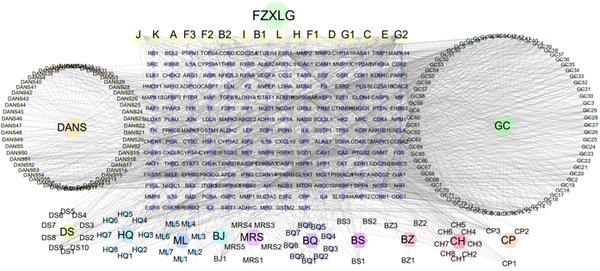-
Home
-
About JCTR
-
Gold Open Access
-
Issues
-
Editorial board
-
Author guidelines
-
Publication fees
-
Online first
-
Special issues
-
News
-
Publication ethics
-
Partners
-
Submit your manuscript
-
Submit your review report
-
Editorial Office
-

This work is licensed under a Creative Commons Attribution-NonCommercial 4.0 International License. ISSN print: 2382-6533 ISSN online: 2424-810X
Volume 9 Issue 3
A network pharmacology and bioinformatics exploration of the possible molecular mechanisms of Fuzheng Xiaoliu Granule for the treatment of hepatocellular carcinoma
Tianyu Fan, Xi Chen, Fangming Yang, Yanjie Li, Qi Gao, Shanyi Li, Xinju Chen, Xiaoqi Chen*
Fan et al. J Clin Tranl Res 2023; 9(3):5
Published online: May 12, 2023
Abstract
Background and aim: Hepatocellular carcinoma (HCC) is one of the ten most common malignant tumors in the world, and it is a major problem in the world. Traditional Chinese medicine (TCM) has many advantages in the prevention and treatment of HCC, but its complicated mechanism of action is difficult to clarify, which limits its research and development. The continuous development of bioinformation technology provides new methods and opportunities for the research of traditional Chinese medicine. This study uses modern network pharmacology and bioinformatic methods to explore the possible molecular mechanism of the Chinese herbal compound Fuzheng Xiaoliu Granule (FZXLG) to treat HCC, to provide a theoretical basis for their clinical application and basic research, to promote the modernization of traditional Chinese medicine and to promote its worldwide application.
Methods: The active ingredients of FZXLG were collected and screened through TCMSP, BATMAN-TCM, and other databases. The targets of FZXLG were predicted by PubChem and SwissTargetPrediction; HCC disease-related targets were obtained by GeneCards, OMIM, and other disease databases, and the potential gene targets of FZXLG for HCC treatment were screened. The "Prescription-TCMs-Ingredients-Targets" network for FZXLG for the treatment of HCC was constructed, along with the screening of core effective components. The differentially expressed genes(DEGs) of HCC tumor and non-tumor adjacent tissues combined with clinical data in the TCGA database were analyzed to obtain the prognostic genes of HCC. Then, FZXLG genes affecting HCC prognosis were screened, and further screening the core target genes. The correlation between core gene expression with prognosis, immune cell infiltration, and immunohistochemical changes in HCC patients was studied. KEGG enrichment analysis and GO enrichment analysis of the FZXLG genes affecting HCC prognosis were performed by using DAVID database. AutoDockTools software was then used for molecular docking verification.
Results: The ten core effective ingredients of FZXLG for HCC treatment included multiple flavonoids ingredients such as quercetin, luteolin, and formononetin. 11 core targets of FZXLG affecting the prognosis of HCC were screened, among which ESR1 and CAT were favorable prognostic factors, while EGF, MMP9, CCNA2, CCNB1, CDK1, CHEK1, and E2F1 were adverse prognostic factors. MMP9 and EGF were positively correlated with six TIIC subsets. The different expression levels of CAT, PLG, AR, MMP9, CCNA2, CCNB1, CDK1, and E2F1 were correlated with the immunohistochemical staining changes in normal liver and liver cancer. KEGG pathway enrichment analysis yielded 33 pathways including cell cycle, p53, hepatitis B, and other signaling pathways. Molecular docking verified that the main core components had good binding to the protective prognostic core targets ESR1 and CAT.
Conclusions: FZXLG may treat HCC through multiple ingredients, multiple targets, and multiple pathways, affecting the prognosis, immune microenvironment, and immunohistochemical changes of HCC.
Relevance for patients: FZXLG is a Chinese herbal compound for the treatment of hepatocellular carcinoma, with significant clinical efficacy. However, the mechanism of action is unclear and lacks theoretical support, which limits its popularization application. This study preliminarily revealed its molecular mechanism, providing a theoretical basis for its clinical application, which can better guide its clinical popularization application, and also provide a new strategy for the treatment of HCC.

DOI: http://dx.doi.org/10.18053/jctres.09.202303.005
Author affiliation
1. Henan University of Chinese Medicine, Zhengzhou City 450000, Henan Province, China
2. Department of Gastroenterology, the First Affiliated Hospital of Henan University of CM, Zhengzhou City 450000, Henan Province, China
*Corresponding author
Xiao-qi Chen
Department of Gastroenterology, the First Affiliated Hospital of Henan University of CM, Zhengzhou City 450000, Henan Province, China.
E-mail: 28050827@qq.com
Handling editor:
Michal Heger
Department of Pharmaceutics, Utrecht University, the Netherlands
Department of Chemistry, Utrecht University, Utrecht, the Netherlands
Department of Pathology, Erasmus Medical Center, the Netherlands
Department of Pharmaceutics, Jiaxing University Medical College, Zhejiang, China
Download
3.1 active ingredients of FZXLG (51.0 KB)
3.2 Potential target of FZXLG (145.0 KB)
3.3 HCC disease gene targets (174.5 KB)
3.4 targets and ingredients in the network (151.5 KB)
3.5 DEGs (1.2 MB)
3.5 down-regulated (211.5 KB)
3.5 edgerOut (1.6 MB)
3.5 up-regulated (1015.5 KB)

